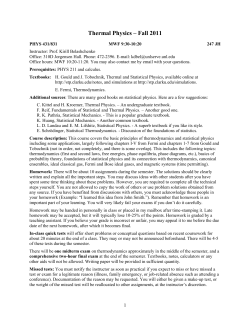
Course Objectives: Text Book: Software: Office Hours: Homework
The Islamic University of Gaza Mechanical Engineering Department Thermodynamics I EMEC 3308 Fall 2014 Course Outline Other activities: Attendance of technical video tapes according to availability and need. Office Hours: NT: 11-12:30 or by appointment Homework: Instructor: Mohammad Abuhaiba, Ph.D., P.E. Email: mhaiba@yahoo.com 1. Teacher Assistant: Eng. Abd Elrahman Shaath 2. Course Objectives: 3. 4. Present a thorough treatment of engineering thermodynamics from the classical viewpoint. Streamline the developments of the energy concept and the first law of thermodynamics. Streamline the developments of the mass and energy balances for a control volume. Enhance the development of the second law of thermodynamics and the concept of entropy. Prepare students to use thermodynamics in engineering practice: Developments of power and refrigeration cycles 1. 2. 3. The final exam is comprehensive. Quizzes and exams are open book. Academic misconduct (giving or receiving aid to another student during exams or quizzes and on homework assignments) will result in an “F” for the course. 1. The Moran, Michael J. and Shapiro, Howard N., “Fundamentals of Engineering Thermodynamics”, 5th Edition, John Wiley & Sons, Inc., New York, 2006. ISBN-13: 978-0-470-03037-0 ISBN-10: 0-470-03037-2 Software: Quizzes and Exams: Miscellaneous: Text Book: Assignments should be completed using MS Word and/or MS Excel Other math tools like MatLab and Mathematica may be used Late assignments will not be accepted. There will also be some CASE STUDIES that must be analyzed. ChemCAD Mathematica MatLab Other relevant software Grading Policy: (subject to change during the semester) Attendance, book, and Laptop Quizzes Homework Paper Presentation Midterm Exam Final Total 5% 10% 10% 5% 20% 50% 100 2. instructor will check e-mail frequently. Responses to your e-mails may require 2-3 days. Plan accordingly. This is a problem-oriented class and the only way that the material can be mastered is with practice solving problems in addition to homework problems. Syllabus C H A P T E R 1: Introductory Concepts and Definitions Using Thermodynamics Describing Systems and Their Behavior Measuring Mass, Length, Time, and Force Specific Volume and Pressure Measuring Temperature C H A P T E R 2: Energy and 1st Law of Thermodynamics Work and Energy Energy Transfer By Heat Energy Accounting: Energy Balance for Closed Systems Energy Analysis of Cycles C H A P T E R 3: Evaluating Properties Fixing the State p–v–T Relation Retrieving Thermodynamic Properties Generalized Compressibility Chart Ideal Gas Model Internal Energy, Enthalpy, and Specific Heats of Ideal Gases Evaluating u and h using Ideal Gas Tables, Software, and Constant Specific Heats Polytropic Process of an Ideal Gas C H A P T E R 4: Control Volume Analysis Using Energy Conservation of Mass for a Control Volume Conservation of Energy for a Control Volume Analyzing Control Volumes at Steady State Transient Analysis C H A P T E R 5: Second Law of Thermodynamics Introducing the Second Law Identifying Irreversibility Applying the Second Law to Thermodynamic Cycles Defining the Kelvin Temperature Scale Maximum Performance Measures for Cycles Operating Between Two Reservoirs Carnot Cycle C H A P T E R 6: Using Entropy Introducing Entropy Defining Entropy Change Retrieving Entropy Data Entropy Change in Internally Reversible Processes Entropy Balance for Closed Systems Entropy Rate Balance for Control Volumes Isentropic Processes Isentropic Efficiencies of Turbines, Nozzles, Compressors, and Pumps Heat Transfer and Work in Internally Reversible, Steady-State Flow Processes C H A P T E R 7: Exergy Analysis Introducing Exergy Defining Exergy Closed System Exergy Balance Flow Exergy Exergy Rate Balance for Control Volumes Exergetic (Second Law) Efficiency C H A P T E R 8: Vapor Power Systems Modeling Vapor Power Systems Analyzing Vapor Power Systems—Rankline Cycle Improving Performance—Superheat and Reheat Improving Performance—Regenerative Vapor Power Cycle C H A P T E R 9: Gas Power Systems INTERNAL COMBUSTION ENGINES Introducing Engine Terminology Air-Standard Otto Cycle Air-Standard Diesel Cycle Air-Standard Dual Cycle GAS TURBINE POWER PLANTS Modeling Gas Turbine Power Plants Air-Standard Brayton Cycle Regenerative Gas Turbines Regenerative Gas Turbines with Reheat and Intercooling Gas Turbines for Aircraft Propulsion Combined Gas Turbine—Vapor Power Cycle Ericsson and Stirling Cycles C H A P T E R 10: Refrigeration and Heat Pump Systems Vapor Refrigeration Systems Analyzing Vapor-Compression Refrigeration Systems Refrigerant Properties Cascade and Multistage Vapor-Compression Systems Absorption Refrigeration Heat Pump Systems Gas Refrigeration Systems
© Copyright 2025





















